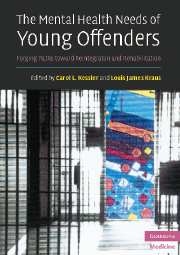Book contents
- Frontmatter
- Contents
- List of contributors
- Foreword
- Acknowledgments
- 1 An overview of child and adolescent mental health needs in the juvenile justice system
- 2 Psychiatric disorders of youth in detention
- 3 Disproportionate minority confinement
- 4 Police interrogation of youth
- 5 Assessing children's competence to stand trial and to waive Miranda rights: new directions for legal and medical decision-making in juvenile courts
- 6 The etiology of antisocial behavior: biopsychosocial risk factors across development
- 7 Substance abuse in youth offenders
- 8 Suicide and delinquent adolescents
- 9 Juvenile sex offenders
- 10 Educational needs of youth in the juvenile justice system
- 11 Science and the juvenile death penalty
- 12 Medical issues regarding incarcerated adolescents
- 13 Mental health screening and assessment in juvenile justice
- 14 Psychological testing in juvenile justice settings
- 15 Psychopharmacology and juvenile delinquency
- 16 Evidence-based treatment for justice-involved youth
- 17 Community alternatives to incarceration
- 18 Innovative problem-solving court models for justice-involved youth
- 19 Ethical issues of youthful offenders: confidentiality; right to receive and to refuse treatment; seclusion and restraint
- 20 Post-adjudicatory assessment of youth
- Index
- References
17 - Community alternatives to incarceration
Published online by Cambridge University Press: 11 August 2009
- Frontmatter
- Contents
- List of contributors
- Foreword
- Acknowledgments
- 1 An overview of child and adolescent mental health needs in the juvenile justice system
- 2 Psychiatric disorders of youth in detention
- 3 Disproportionate minority confinement
- 4 Police interrogation of youth
- 5 Assessing children's competence to stand trial and to waive Miranda rights: new directions for legal and medical decision-making in juvenile courts
- 6 The etiology of antisocial behavior: biopsychosocial risk factors across development
- 7 Substance abuse in youth offenders
- 8 Suicide and delinquent adolescents
- 9 Juvenile sex offenders
- 10 Educational needs of youth in the juvenile justice system
- 11 Science and the juvenile death penalty
- 12 Medical issues regarding incarcerated adolescents
- 13 Mental health screening and assessment in juvenile justice
- 14 Psychological testing in juvenile justice settings
- 15 Psychopharmacology and juvenile delinquency
- 16 Evidence-based treatment for justice-involved youth
- 17 Community alternatives to incarceration
- 18 Innovative problem-solving court models for justice-involved youth
- 19 Ethical issues of youthful offenders: confidentiality; right to receive and to refuse treatment; seclusion and restraint
- 20 Post-adjudicatory assessment of youth
- Index
- References
Summary
Introduction
The central reason behind the creation of the juvenile justice system at the beginning of the twentieth century was the belief, that in contrast to adult offenders, delinquents were amenable to change in their antisocial behaviors. Therefore, the juvenile courts sought to capitalize on this opportunity and provide rehabilitation, not solely punishment. The rate of recidivism among young offenders certainly supports the notion of developing programs aimed at reforming delinquents (Snyder, 1988). The reduction in youth crime and its personal and economic costs to the individual and communities easily justify the expense of intervention (Schoenwald et al., 1996). In addition, it has been estimated that each delinquent that continues onto an adult criminal career costs society $1.3–1.5 million (Cohen, 1998).
The founding principle of the opportunity for rehabilitation has been questioned from the start as to whether effective interventions truly exist with juvenile delinquents. Early intervention efforts were based on an individualized approach to meeting the needs of the particular youth before the court. While some intervention models were based on theoretical speculations regarding the causes of delinquency, few were derived from direct research on the causes and correlates of antisocial behavior in youth. Most reflected an application of general models of psychopathology and treatment to the special case of delinquency, such as Aichhorn's psychoanalytic approach (Aichhorn, 1935). A series of research reviews in the late 1970s supported the popular belief that “nothing works” with delinquents (Lipton et al., 1975; Greenberg, 1977; Romig, 1978; Sechrest et al., 1979).
Keywords
- Type
- Chapter
- Information
- The Mental Health Needs of Young OffendersForging Paths toward Reintegration and Rehabilitation, pp. 368 - 384Publisher: Cambridge University PressPrint publication year: 2007



